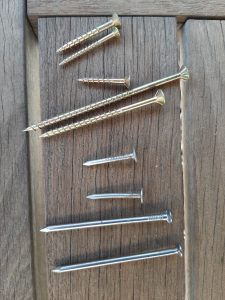Screws and nails are regarded as the unsung heroes in the fastener segment, and rightfully so, owing to their use in an array of applications, ranging from wooden house frames and flooring to outdoor decking and kitchen cabinetry.
However, deciding when to use one over the other can be a tricky affair, both for novice as well as seasoned DIYers. But here’s the lowdown on screws vs. nails, so that you can determine whether to nail or screw it.
The first most important thing to consider when choosing between screws and nails is the nature of the job you’re working on, and the materials involved. Generally, nails are a preferred choice among carpenters as they’re easy to work with, and save a considerable amount of time. But if your project demands superior strength, screws are your best choice.

Screws vs. Nails – The Basics
Both screws and nails are fasteners, and have a shank with a head on one end. That is the end of the similarities between the two fasteners. So, how is a nail distinct from a screw?
The easiest way to tell the two apart is simply by looking at the shank — screws have a threaded portion along their shank, and nails don’t.
There is a type of nail that can appear to be threaded, but it’s not a thread, rather a series of rings along the shank of the nail, these are known as annular ring nails, and give superior holding power.
Furthermore, nails are mounted with hammers, whereas screws are installed with screwdrivers or impact drivers, which is the reason for the helical threads. Nails can be installed quickly, and are cheaper than screws.
Screws Explained
Screws can be made from several different materials, most commonly steel. Shorter screws have helical threads along their shank, whereas longer screws often times have an unthreaded portion directly below their head. The unthreaded shaft portion of the screw provides a higher level of security with the connected objects.
For example, if you’re trying to join a sheet of plywood with a 2 x 4, using a partially threaded screw is perhaps your best option, and here’s why! When you install a fully threaded screw in this scenario, you will notice a small gap between the plywood and 2 x 4.
This gap is caused due the fully threaded shank going through both materials, but falling short of binding them together, as part of the threaded portion is stuck in the 2 x 4.
Contrarily, the unthreaded portion of a partially threaded screw will remain in the 2 x 4, allowing its threaded portion to run all the way into the plywood tightly without leaving a gap between the two pieces.
Types of Screws
Wood screws – this type of screw has an unthreaded portion under its head to allow two pieces of wood to attach together without a gap.
Drywall screws – as the name suggests, this type of screw is geared specifically to install drywall panels. However, it is recommended that you use self-drilling metal stud framing screws if you’re fastening drywall over metal studs.
Masonry screws – also referred to as self-tapping screws, masonry screws prove handy for a wide range of base materials including concrete, brick, mortar joints/block and CMU. They are made from either stainless or carbon steel, and may or may not come with corrosion coating.
MDF screws – short for medium density fiberboard, MDF screws look like wood screws, but require predrilling, and using a screwdriver may cause the wood to split.
Decking screws – another fastener that looks similar to wood screws, but are a little longer, and as the name suggests are a good choice for exterior decking applications.
Nails Explained
Nails are another type of fastener, but unlike screws feature a flat head, smooth shank, sharp point, and are driven by a hammer rather than a screwdriver. They are generally made from metal, and are mostly used to join two separate pieces of wood. Just like screws, there are several different types of nails to choose from including:
Common (round head) nails – this type of nails is generally used in woodworking, and also called round wire nails or simply “nails”. Their length varies between 1 – 6 inches, where the largest ones are referred to as spikes. They are especially a good fit for applications where appearance isn’t important, but strength is paramount.
Oval head nails – the only difference between oval head nails and common nails is the oval shape of the head, which allows them to be driven below the surface of the wood for a more attractive finished appearance.
Casing nails – casing nails are distinct from oval head nails for their tapered head, which offers twofold benefits — provide more holding power, and can be removed with minimal damage to the wood.
Box nails – a lot thinner than round head nails, box nails span between 1 – 3 inches, and are a preferred choice for driving into smaller pieces of wood.
Finishing nails – another popular choice among DIYers, finishing nails feature a very small head, which allows them to be driven below the surface, resulting in a clean finish.
Brad nails – this type of nails is far shorter and smaller than finishing nails, allowing their body to be driven closer into wood. They are mostly used in indoor woodworking or carpentry, because of their ability to be hidden in your project.
Screws vs. Nails – Which Fastener is Right for your Project?
To determine whether you need to use nails or screws for the job, it is a good idea to understand the difference between grip strength and shear strength. Grip strength refers to the ability of a nail to draw wood together.
You will need a higher amount of grip strength when force is placed vertically on a fastener and the pieces of wood it’s joining together. Decking is a great example where you will need a lot of grip strength as vertical force is applied on the decking planks and joists when you walk on the deck.
The amount of force a fastener can handle from the sides is referred to as shear strength. So, you will need a fastener that offers a lot of shear strength when connecting the joist to the deck in the aforementioned deck example.
Compared to nails, screws are relatively brittle, hence will snap when you apply shear force to the side. But on a brighter note, screws do provide a lot of grip and tensile strength, hence work well at keeping wood together when prone to vertical force.
Unless you’ve got really poor quality nails, you will rarely come across one that snaps when subjected to shear force. On the downside, nails do not offer a lot of grip or tensile strength, but when it comes to shear strength, they are hard to beat!
But deciding to use a nail or a fastener depends entirely on your project, where it’s easier to remove a screw in case of a mess-up, and nails are more aesthetically pleasing in some scenarios.
Nails are often a go-to choice for large projects such as installing hardwood floors and house framing for two main reasons — they’re typically stronger, and less expensive. Additionally, nails are easier to install, since you just have to hammer their smooth heads into the wood.
Screws, in contrast are a preferred choice for small and midsize projects such as decking, because they offer optimal control when inserting and extracting. They’re also a favorite fastener for temporary jobs, because while they can create tight bonds, they can also be removed easily if the need arises.
Screws are also preferable when working with more delicate materials such as drywall and plaster, because they cause less vibrations, and potential damage. And given that screws offer great tensile strength, they are great for projects when joined pieces are susceptible to tension like porch railings, and kitchen cabinetry.
Building Codes
It may be the case that the project being undertaken is subject to regulations generally known as “building codes“, in this case, the code will dictate the materials which must be used, and this will normally also include specific fasteners.
Pros of Screws
- Stronger holding power – screws offer great tensile strength, and more so if used together with wood glue, making them a great choice for holding two pieces of wood together.
- Easy to unfasten – if you join pieces incorrectly or you need to disconnect them, you can simply unscrew them.
- Safe to install with a power tool – an impact driver or cordless screwdriver is considered to be much safer to use than a nail gun.
Cons of Screws
- Takes longer to drive – whether you use a manual screwdriver or an impact driver, it takes a fair amount of time and effort to drive and tighten a screw.
- Can split wood easily – owing to their thread, screws are usually thicker than nails with similar properties, making it easier to split the wood you’re working with.
- Cannot withstand much twisting – even though screws provide great tensile strength, they can break easily when twisted.
- Easy to strip – when used improperly such as with the wrong tools, screws can strip, leaving you with a damaged screw that’s frustrating to remove once stripped.
- Bigger range of tools required – Due to the many variations in types of screws, you will need a variety of screw driving tools to be able to deal with the different types of screw-head that you may come up against.
- More expensive – compared to nails, screws are more expensive, so may burn a hole in your pocket if used for a large scale project.
Pros of Nails
- Easy and fast to drive – it takes a split second to drive a nail with a pneumatic nail gun
- Can withstand twisting – owing to their no-frills construction, nails can be bent and twisted many more times than a screw without breaking them.
- Difficult to tamper – screws can be removed easily with a screwdriver, but removing a nail is a bit more challenging.
Cons of Nails
- Difficult to remove – while it as an advantage, removing nails may damage the wood it’s driven into.
- Not a great choice for fragile applications – given that they are driven by force, driving nails into fragile applications can cause damage to the workpiece.
Final Thoughts:
Nails and screws offer their own set of advantages and disadvantages, and can be used interchangeably at times. The main difference between the two fasteners is the way they are driven into the workpiece.
Another key difference lies in the design, where screws feature threads that cut into the wood, whereas nails have an unthreaded shank that is driven into the wood with great force. Whether you should use nails or screws really boils down to the project you’re working on.
